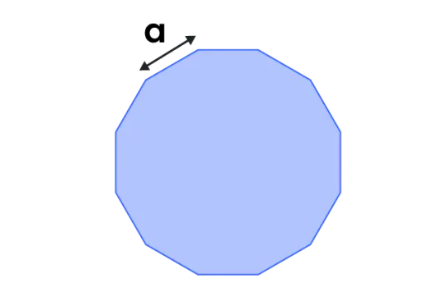1. What is a Regular Polygon Area Calculator?
Definition: This calculator computes the circumradius, inradius (apothem), and area of a regular polygon given the number of sides \( n \) and side length \( a \). A regular polygon is a polygon with all sides and angles equal. The calculator supports length units (mm, cm, m, in, ft, yd) and area units (mm², cm², m², in², ft², yd²), defaulting to m for inputs and lengths, and m² for area.
Purpose: It aids in geometry education and practical applications by calculating key properties of regular polygons, useful in fields like architecture, design, and engineering for creating symmetrical shapes.
2. How Does the Calculator Work?
The calculator uses the following formulas for a regular polygon with \( n \) sides and side length \( a \):
- Circumradius: \( R = \frac{a}{2 \sin(\pi/n)} \)
- Inradius/Apothem: \( r = \frac{a}{2 \tan(\pi/n)} \)
- Area: \( A = \frac{n a r}{2} \)
Steps:
- Input the number of sides \( n \) and side length \( a \), with the unit defaulting to m.
- Select the desired output units for circumradius, inradius, and area (defaulting to m and m²).
- Validate inputs: ensure \( n \geq 3 \) and \( a > 0 \).
- Convert the side length to meters for calculation.
- Compute the circumradius, inradius, and area using the formulas above.
- Convert the results to the selected units.
- Display results with lengths and area to 4 decimal places.
3. Importance of Regular Polygon Area Calculations
Regular polygon calculations are essential for:
- Geometry: Understanding the properties of symmetrical shapes like triangles, squares, and hexagons.
- Design: Creating patterns or structures with regular polygons, such as tiling or architectural elements.
- Engineering: Analyzing shapes in structural design, where polygons distribute forces evenly.
4. Using the Calculator
Examples:
- Equilateral Triangle: Sides \( n = 3 \), \( a = 2 \) m, Outputs in m and m²
Circumradius: \( R = \frac{2}{2 \sin(\pi/3)} = \frac{2}{2 \cdot \sqrt{3}/2} \approx 1.1547 \) m
Inradius: \( r = \frac{2}{2 \tan(\pi/3)} = \frac{2}{2 \cdot \sqrt{3}} \approx 0.5774 \) m
Area: \( A = \frac{3 \cdot 2 \cdot 0.5774}{2} \approx 1.7321 \) m².
- Square: Sides \( n = 4 \), \( a = 1 \) m, Circumradius in cm, Inradius in mm, Area in cm²
Circumradius: \( R = \frac{1}{2 \sin(\pi/4)} \approx 0.7071 \) m = 70.7107 cm
Inradius: \( r = \frac{1}{2 \tan(\pi/4)} = 0.5000 \) m = 500.0000 mm
Area: \( A = \frac{4 \cdot 1 \cdot 0.5}{2} = 1.0000 \) m² = 10000.0000 cm².
- Hexagon: Sides \( n = 6 \), \( a = 0.5 \) m, Outputs in m and ft²
Circumradius: \( R = \frac{0.5}{2 \sin(\pi/6)} = 0.5000 \) m
Inradius: \( r = \frac{0.5}{2 \tan(\pi/6)} \approx 0.4330 \) m
Area: \( A = \frac{6 \cdot 0.5 \cdot 0.4330}{2} \approx 0.6495 \) m² = 6.9922 ft².
5. Frequently Asked Questions (FAQ)
Q: What is a regular polygon?
A: A regular polygon is a 2D shape with all sides and angles equal, such as an equilateral triangle (\( n = 3 \)), square (\( n = 4 \)), or hexagon (\( n = 6 \)).
Q: Why do inputs and outputs default to m and m²?
A: Meters (m) and square meters (m²) are the default units to provide a standard metric base, ensuring consistency in calculations, but you can convert to other units as needed.
Q: What are the circumradius and inradius?
A: The circumradius is the radius of the circle passing through all vertices of the polygon, while the inradius (or apothem) is the radius of the circle inscribed within the polygon, touching the midpoints of each side.
Regular Polygon Area Calculator© - All Rights Reserved 2025
 Home
Home
 Back
Back
